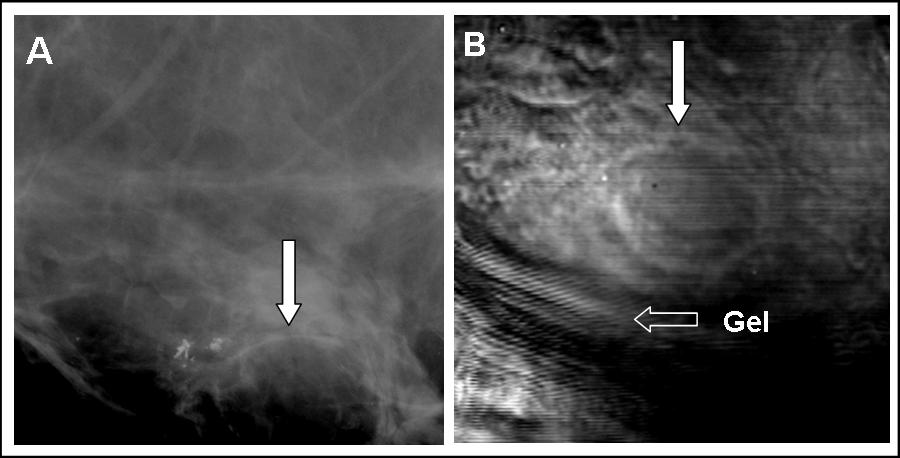Vibro-acoustography:
New Breast Imaging Modality Shows Lesions More Clearly
Azra Alizad, aza@mayo.edu , 507-254-5970,
Dana H. Whaley, James F. Greenleaf and
Mostafa Fatemi, fatemi@mayo.edu, 507-261-4089
Mayo Clinic College of Medicine
Rochester, MN 55905
Popular Version of Paper 3aBBa7
Presented Wednesday morning, June 6, 2007
153 rd ASA Meeting, Salt Lake City, UT

The patient has cysts near the nipple on her right breast. There are several calcifications near the largest cyst. Panel A shows the corresponding x-ray, Panel B: vibro-acoustography (VA) image at 3cm depth. (The patient moved up slightly between images). The cyst can be seen clearly in VA.[Reproduced from IEEE UFFC]
Palpation, the examination of tissue through the use of touch, remains one of the simplest yet effective methods for detecting breast tumors . It is well known that breast tumors are often much harder than the normal tissue, and sensing stiff tissue can reveal early signs of a breast tumor. However, the sense of touch is not sensitive enough to detect small or very deep lesions.
Mammography has been the main tool of breast imaging for many years, mostly to detect microcalcifications, which in some cases are associated with breast malignancies. But this method has limited sensitivity, especially in dense breasts. Conventional "B-mode" ultrasound imaging has been increasingly used for breast imaging. However, this method is not sensitive to tissue stiffness. Ultrasound imaging also suffers from a snowy noise pattern, called speckle artifact, which masks small structures; thus, it is difficult to detect microcalcifications and some types of breast masses with this method.
Significant effort has been invested in developing improved breast imaging techniques, especially those that provide palpation-like information. Vibro-acoustography (VA) is an innovative, non-invasive imaging method that is sensitive to tissue stiffness. Typical VA images have high resolution and high contrast. Both soft tissue and microcalcifications can be imaged with VA, making this method is an ideal tool for breast imaging. It is currently in the experimental stage and cannot be used for clinical practice in the present form.
This paper presents recent progress in vibro-acoustography of human breast. Matching VA and mammography images are acquired using a machine that displays them together and lines them up. Images of various types of breast masses are investigated and their characteristic features are compared. The results, based on the data collected from an ongoing study, indicate that the characteristics of image features from different types of breast lesions may be used for differentiation of breast masses. A sample VA image of a patient with a cyst is shown.
It is noted that more data from a larger population are needed to establish the results in a statistical sense.
Work supported by NIH Grant EB-00535 and Grant BCTR0504550 from the Susan G. Komen Breast Cancer Foundation.
Disclosure: Parts of the techniques used here are patented by MF and JFG.